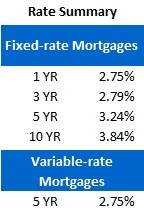David Larock in Mortgages and Finance, Home Buying, Toronto Real Estate News
 Last week the euro-zone finance ministers increased the size of the European Stability Mechanism (ESM) by another US$670 billion in their latest attempt to restore investor confidence in the European bond market. In their typical fashion, the ministers tried to boost the fund by just enough to satisfy investors, but not by enough to further inflame the voters (and taxpayers) in their member countries who have become increasingly wary of the bailout brigade.
Last week the euro-zone finance ministers increased the size of the European Stability Mechanism (ESM) by another US$670 billion in their latest attempt to restore investor confidence in the European bond market. In their typical fashion, the ministers tried to boost the fund by just enough to satisfy investors, but not by enough to further inflame the voters (and taxpayers) in their member countries who have become increasingly wary of the bailout brigade.
The latest expansion was a response to rising bond yields in Italy and most worryingly in Spain, a country that is now mired in what is likely to be a deep and long-lasting recession. Spain’s economy is slowing at the same time that the cost of its debt, measured by yield, is rising (Spain’s ten-year bond yield has risen about .5% over the last month). While the Spanish government wants to provide stimulus to try to kick-start its economy, it must instead choose between raising taxes or reducing spending by almost 20%, in order to meet the austerity targets imposed by the Troika (the European Central Bank, the International Monetary Fund and the European Commission).
Unlike in Italy, where the problem is too much government debt, Spain’s biggest problem is too much private debt (Spain’s total private debt outstanding is more than double its GDP). If Spain suffers a banking crisis its cash-strapped government is in no position to provide bail outs, and many analysts question whether there is any euro-zone stability mechanism or emergency fund currently in existence that could provide a firewall sufficient enough to prevent widespread contagion if that transpires (consider that many German and French banks have large exposures to Spanish banks).
The solution so far has been temporary support by the European Central Bank (ECB), through their Long-Term Refinancing Operation (LTRO) which allows Spanish (and other euro-zone) banks to pledge almost worthless sovereign bonds as collateral for three-year loans at 1%. Spain’s banks have then leveraged those loans at a thirty to one ratio to buy Spanish government bonds at 5%+, booking a nice profit for their trouble. But not even the ECB’s trillion dollar trash-for-cash program has been able to keep Spanish bond yields under 5% for long, and cash injections aside, the market for any kind of Spanish debt is shrinking fast. In the end, the ECB’s temporary loans merely buy more time (and what happens in three years when these loans are supposed to expire?)
I am increasingly convinced that the only hope for restoring investor confidence and immunizing the euro zone’s struggling governments and their economies from the threat of panic-level bond yields is to create a euro bond that is backed by the full faith and credit of all seventeen euro-zone member countries. All other solutions to date have just been duct tape and bailing wire.
Five-year Government of Canada bond yields fell 8 basis points last week, closing at 1.57% on Friday as investor optimism about the strength of the global economic recovery began to wane. Falling bond yields didn’t stop Canadian lenders from raising fixed-mortgage rates on most terms however, and market five-year rates are now being offered in the 3.29% range. The gap between the five- and ten-year fixed rates continues to narrow (my best ten-year fixed rate is unchanged at 3.84%), and as such, I think that locking in a fixed rate for the next decade is an option well worth considering.
Variable-mortgage rates are still too close to fixed rates to justify their inherent risk, in my (grudging) opinion.
The bottom line: A euro-bond solution won’t solve all of the euro zone’s problems but it should stop yo-yoing bond yields in countries like Spain. Of course, the Germans are still running the show and since they remain adamantly opposed to the idea of euro bonds, fear and uncertainty about the euro zone’s future will continue to weigh on investors. This bend-but-don’t-break way of managing the euro-zone debt crisis virtually ensures continued bond-yield volatility in Europe, and it should also keep driving up demand for the relative safety of GoC bonds. This, by association, will help keep our fixed-mortgage rates at ultra-low levels for the foreseeable future.
David Larock is an independent mortgage planner and industry insider specializing in helping clients purchase, refinance or renew their mortgages. David's posts appear weekly on this blog (movesmartly.com) and on his own blog integratedmortgageplanners.com/blog). Email Dave



